Epithelium, one of the four primary
tissues of the body, is characterized by
- A free edge or surface and
- A basal lamina which anchors it
to the underlying structure.
Unlike other tissue types, epithelia
consist mostly of cells, with little intervening space between the
adjacent cells.
- The classification of an
epithelial layer is based on the shape of cells that comprise
it,
- Particularly the cells on
its free or exposed surface, and
- The number of cellular layers.
- These structural features also
reflect the principal activities of the epithelium.

Learning Objectives:
- Understand how epithelia are
classified into simple, stratified, and pseudostratified
types and the usual functional significance of each type.
- Recognize the (extracellular)
basement membrane of epithelia, apical specializations such
as the terminal web, and ultrastructural features of the various
types of intercellular junctions.
- Understand that epithelium
forms barriers and compartments by covering and lining the
body’s outer and inner surfaces.
- Understand that epithelium is
specialized for protection (or as a barrier), transport,
absorption, and secretion.
Let's start with
simple squamous epithelium. |